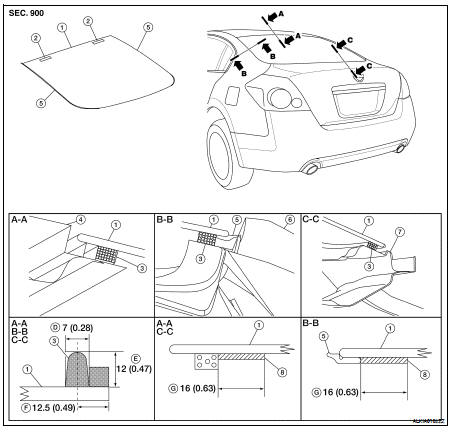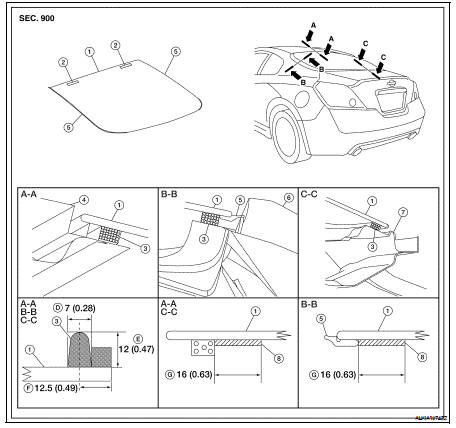Nissan Altima (L32) 2007-2012 Service Manual: Rear window glass
Components - Sedan

1. Rear window glass
2. Spacer
3. Adhesive
4. Roof panel outer
5. Rear window molding
6. Body side outer
7. Parcel shelf
8. Primer
D. 7 (0.28)
E. 12 (0.47)
F. 12.5 (0.49)
G. 16 (0.63)
Components - Coupe

1. Rear window glass
2. Spacer
3. Adhesive
4. Roof panel outer
5. Rear window molding
6. Body side outer
7. Parcel shelf
8. Primer
D. 7 (0.28)
E. 12 (0.47)
F. 12.5 (0.49)
G. 16 (0.63)
Removal and Installation
REMOVAL
1. Partially remove the rear of the headliner (rear edge). For Sedan Refer to INT-42, "Removal and Installation".
For Coupe Refer to INT-20, "Removal and Installation" 2. Remove the rear parcel shelf finisher. Refer to INT-17, "Removal and Installation".
3. Remove the connectors and grounds for the rear window defogger and printed antenna.
4. Apply protective tape around the rear window glass to protect the painted surface from damage.
• After removing moldings, remove glass using piano wire or power cutting tool (A) and an inflatable pump bag (B).

• If the rear window glass is to be reused, mark the body and the glass with mating marks. WARNING: When cutting the glass from the vehicle, always wear safety glasses and heavy gloves to help prevent glass splinters from entering your eyes or cutting your hands.
CAUTION: • When the rear window glass is to be reused, do not use a cutting knife or power cutting tool.
• Be careful not to scratch the glass when removing.
• Do not set or stand the glass on its edge. Small chips may develop into cracks.
INSTALLATION
Installation is in the reverse order of removal.
• Use a genuine Nissan Urethane Adhesive Kit (if available) or equivalent and follow the instructions furnished with it.
• While the urethane adhesive is curing, open a door window. This will prevent the glass from being forced out by passenger compartment air pressure when a door is closed.
• The molding must be installed securely so that it is in position and leaves no gap.
• Inform the customer that the vehicle should remain stationary until the urethane adhesive has completely cured (preferably 24 hours). Curing time varies with temperature and humidity. WARNING: • Keep heat and open flames away as primers and adhesive are flammable.
• The materials contained in the kit are harmful if swallowed, and may irritate skin and eyes. Avoid contact with the skin and eyes.
• Use in an open, well ventilated location. Avoid breathing the vapors. They can be harmful if inhaled.
If affected by vapor inhalation, immediately move to an area with fresh air.
• Driving the vehicle before the urethane adhesive has completely cured may affect the performance of the rear window in case of an accident.
CAUTION: • Do not use an adhesive which is past its usable term. Shelf life of this product is limited to six months after the date of manufacture. Carefully adhere to the expiration or manufacture date printed on the box.
• Keep primers and adhesive in a cool, dry place. Ideally, they should be stored in a refrigerator.
• Do not leave primers or adhesive cartridge unattended with their caps open or off.
• The vehicle should not be driven for at least 24 hours or until the urethane adhesive has completely cured. Curing time varies depending on temperature and humidity. The curing time will increase under lower temperature and lower humidity.
Inspection
REPAIRING WATER LEAKS
Leaks can be repaired without removing and reinstalling glass.
If water is leaking between the urethane adhesive material and body or glass, determine the extent of leakage.
This can be done by applying water to the side window area while pushing glass outward.
To stop the leak, apply primer (if necessary) and then urethane adhesive to the leak point.

 Windshield glass
Windshield glass Front door glass
Front door glass